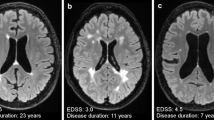Abstract
This study assessed whether dysfunction of the blood-brain barrier is an obligatory early event in lesion formation in multiple sclerosis. Dual-echo and T1-weighted magnetic resonance imaging after the injection of a triple dose (0.3 mmol/kg) of gadolinium-DTPA were obtained from ten patients with relapsing-remitting multiple sclerosis every week for 2 months. Sixty-four newly active lesions were detected by the two techniques. All the 44 new lesions seen on dual-echo scans enhanced during the early phases of their formation: 33 at their first appearance, 10 1 week before their appearance on the dual-echo scans, and one the week thereafter. When the every fourth (monthly) scan was analyzed, a total of 55 newly active lesions were detected (i.e., 14% active lesions would have been missed compared to the number found on weekly scanning). Thirty-one of them were detected by both dual-echo and triple-dose scans, 15 only by enhanced scans, and nine only by dual-echo scans. This study confirms that with highly sensitive magnetic resonance imaging techniques dysfunction of the blood-brain barrier is an obligatory early event in new lesion formation in relapsing-remitting multiple sclerosis.
Similar content being viewed by others
Author information
Authors and Affiliations
Additional information
Received: 9 September 1998 Received in revised form: 21 January 1999 Accepted: 2 February 1999
Rights and permissions
About this article
Cite this article
Tortorella, C., Codella, M., Rocca, M. et al. Disease activity in multiple sclerosis studied by weekly triple-dose magnetic resonance imaging. J Neurol 246, 689–692 (1999). https://doi.org/10.1007/s004150050433
Issue Date:
DOI: https://doi.org/10.1007/s004150050433




